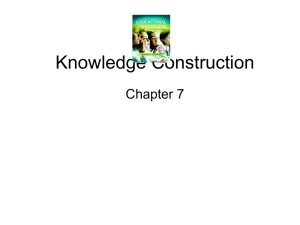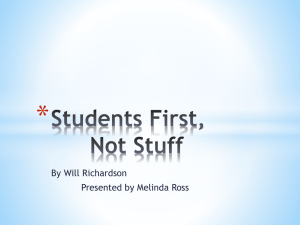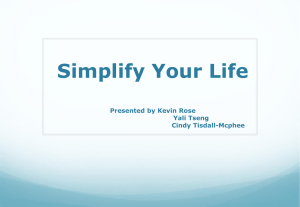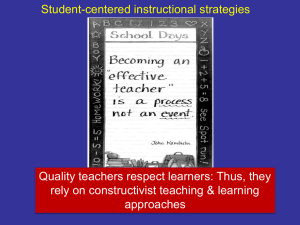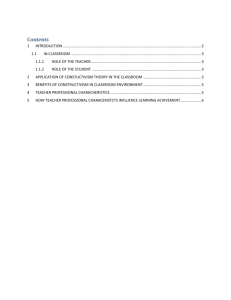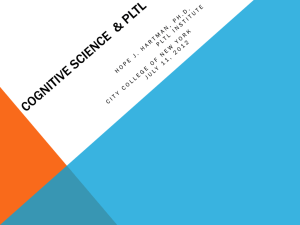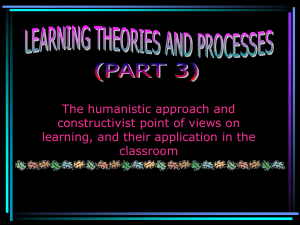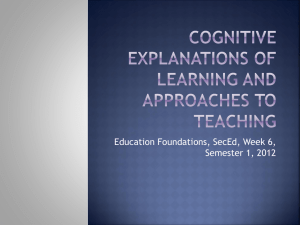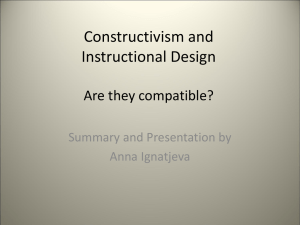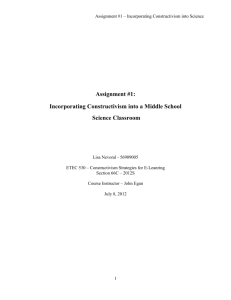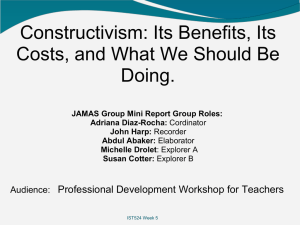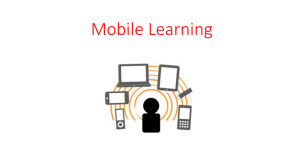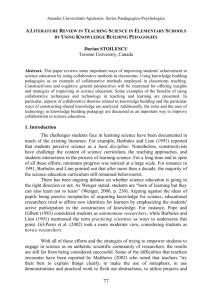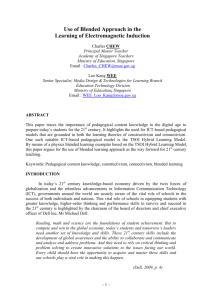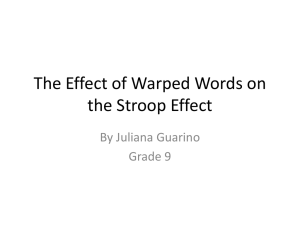the PowerPoint presentation - e
advertisement
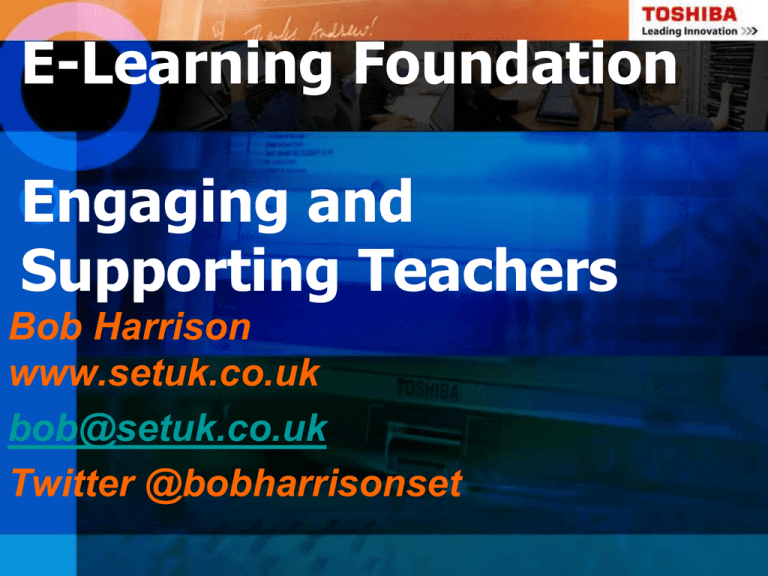
E-Learning Foundation Engaging and Supporting Teachers Bob Harrison www.setuk.co.uk bob@setuk.co.uk Twitter @bobharrisonset Resistance To Innovation “ Students today cannot prepare bark to calculate their problems. They depend on their slates which are more expensive. What will they do when the slate is dropped and it is broken? They will be unable to write.” 1703 Teachers’ Conference Resistance To Innovation “ Students today depend on paper too much. They do not know how to write on slate without getting chalk dust on themselves. They cannot clean a slate properly. What will they do when they run out of paper?” 1815 Principals’ Publication Resistance To Innovation “ Students today depend too much on ink. They do not know how to use a penknife to sharpen a pencil. Pen and ink will never replace the pencil.” National Association 1907 Resistance To Innovation “ Students today depend on store bought ink. They do not know how to make their own. When they run out of ink they will be unable to write words or ciphers until their next trip to the settlement. This is a sad commentary on modern education.” 1928 USA Teacher Resistance To Innovation “ Students today depend on these expensive fountain pens. They can no longer write with a straight pen and nib. We parents must not allow them to wallow in such luxury to the detriment of learning how to cope in the real business world which is not so extravagant.” 1941 PTA Gazette Resistance To Innovation “ Ball point pens will be the ruin of education in our country. Students use these devices and throw them away! The American values of thrift and frugality are being discarded. Business and banks will never allow such expensive luxuries.” 1950 Federal Teachers Resistance To Innovation “ Computers give students an unfair advantage. Therefore students who use computers to analyse data or create displays will be eliminated from the Science Fair.” 1988 Science Fair Judge – Apple Classroom of Tomorrow Resistance To Innovation “ Education as we know it is being reformed and for the worse. More and more schools are shuffling kids into computer labs and knowledge is being left at the door.” 2012 Huffington Post Sigmoid Curve 1. One 2. Thirteen 3. Thirty - one 1. One 2. Thirteen 3. Thirty - one Are the New Millennium Learners Making the Grade? Are the New Millennium Learners Making the Grade? Technology use and Educational performance in Pisa Centre for Educational Research and Innovation The Future of Learning: Preparing for Change The Future of Learning: Preparing for Change European Commission Joint Research Centre Institute for Prospective Technological Studies Authors: Christine Redecker, Miriam Leis, Matthijs Leendertse, Yves Punie, Govert Gijsbers, Paul Kirschner, Slavi Stoyanov and Bert Hoogveld Human-Computer Interaction in 2020 Being Human – Human – Computer interaction in the Year 2020 Edited by Richard Harper, Tom Rodden, Yvonne Rogers and Abigail Sellen Published by Microsoft Equipping Every Learner for the 21st Century Equipping Every Learner for the 21st Century The Future of Thinking The Future of Thinking Learning Institutions in a Digital Age Cathy N. Davidson and David Thea Goldberg with the assistance of Zoe Marie Jones The Learning Society The Learning Society The Digital World Of Young Children: Impact on Emergent Literacy The Digital World Of Young Children: Impact on Emergent Literacy Jay Blanchard | Terry Moore Arizona State University College of Teacher Education and Leadership Disrupting College Learning In a Digital age Transforming learning through mEducation Education Reform For The Digital Era The Digital Learning Imperative Innovating Pedagogy 2012 System Upgrade Decoding Learning The Impact Of Digital Technology On Learning The Impact Of Digital Technology On Learning Innovating Pedagogy 2013 What it takes to learn There is a common thread in our understanding of learning 1890 . . 1940 . . 1960 . . 1980 . . 2000 . . - the learner is an active agent in the learning process John Dewey Jean Piaget Lev Vygotsky Jerome Bruner Paulo Freire Gordon Pask Terry Winograd Seymour Papert Lauren Resnick John Seely Brown Ference Marton Roger Säljö John Biggs Jean Lave share a common conception of the learning process Inquiry-based education Constructivism Mediated learning Discovery learning Learning as problematization Learning as conversation Problem-based learning Reflective practice Meta-cognition Experiential learning Learner-oriented approach Social constructivism Situated learning What it takes to learn does not change Books, Blackboards, Slides Broadcasts, Overhead projectors Tape-slides Interactive whiteboards, Powerpoint Web-pages, Podcasts Modelling tools Simulations Chat-rooms Online conferences Multiplayer games Wikis Blogs 33 Learning through attention Inquiry-based learning Constructivism Mediated learning Discovery learning Learning as conversation Problem-based learning Reflective practice Meta-cognition Experiential learning Learner-oriented approach Social constructivism Situated learning Common classroom activities Q Which three of the following do you do most often in class? Copy from the board or a book 52% Listen to a teacher talking for a long time 33% Have a class discussion 29% Take notes while my teacher talks 25% Work in small groups to solve a problem 22% Spend time thinking quietly on my own 22% Have a drink of water when I need it 17% Talk about my work with a teacher 16% Work on a computer 16% Listen to background music 10% Learn things that relate to the real world 10% Have some activities that allow me to move around Teach my classmates about something 9% 8% Create pictures or maps to help me remember 7% Have a change of activity to help focus 7% Have people from outside to help me learn Learn outside in my school’s grounds 4% 3% Most preferred ways to learn In which three of the following ways do you prefer to learn? 55% In groups By doing practical things 39% With friends 35% By using computers 31% Alone 21% From teachers 19% From friends 16% By seeing things done 14% With your parents 12% By practising 9% In silence 9% By copying 8% At a museum or library By thinking for yourself From others Other Base: All pupils (2,417) 5% 6% 3% 1% Source: Ipsos MORI Learners of the future Learners of The Future Teachers of the future…? BSF “One of the clinical definitions of insanity is doing the same thing over and over again and expecting to get a different result.” John Abbott Learning 1908 1958 2004 2010 2012 Learning 1908 1958 2010 2012 Centre for Learning and Performance TechnologiesTop Tools for Learners 2013. 1. Twitter 2. Google Drive/Docs 3. You Tube 4. Google Search 5. PowerPoint 6. Evernote 7. Dropbox 8. WordPress 9. FaceBook 10. Google+/Hangouts 11. Moodle 12. LinkedIn 13. Skype shallow deep the ewords framework Change the content, process and location of learning Swap traditional practices with ICT Exchange Deepen learning The ewords framework through the Engage Extend use of ICT learners by using a richer mix of Enhance media Enable learners to take control of their own learning Empower Enrich Martin Blows It’s not about the technology …. … it’s about new thinking. The only barriers are in our heads! Almost all the barriers are in our heads. We cannot change policy but we can change practice. Policy or Practice? "The reality is that the circumstances, rationale and representations for learning have changed....lets confront it "Richard Noss #altc2012
